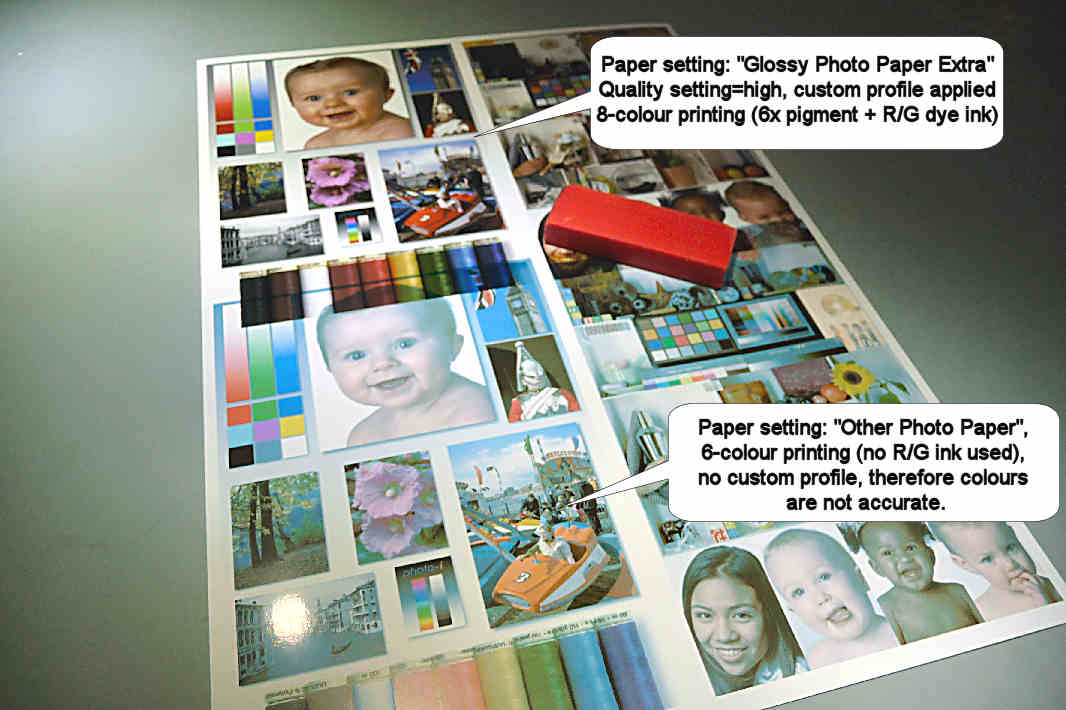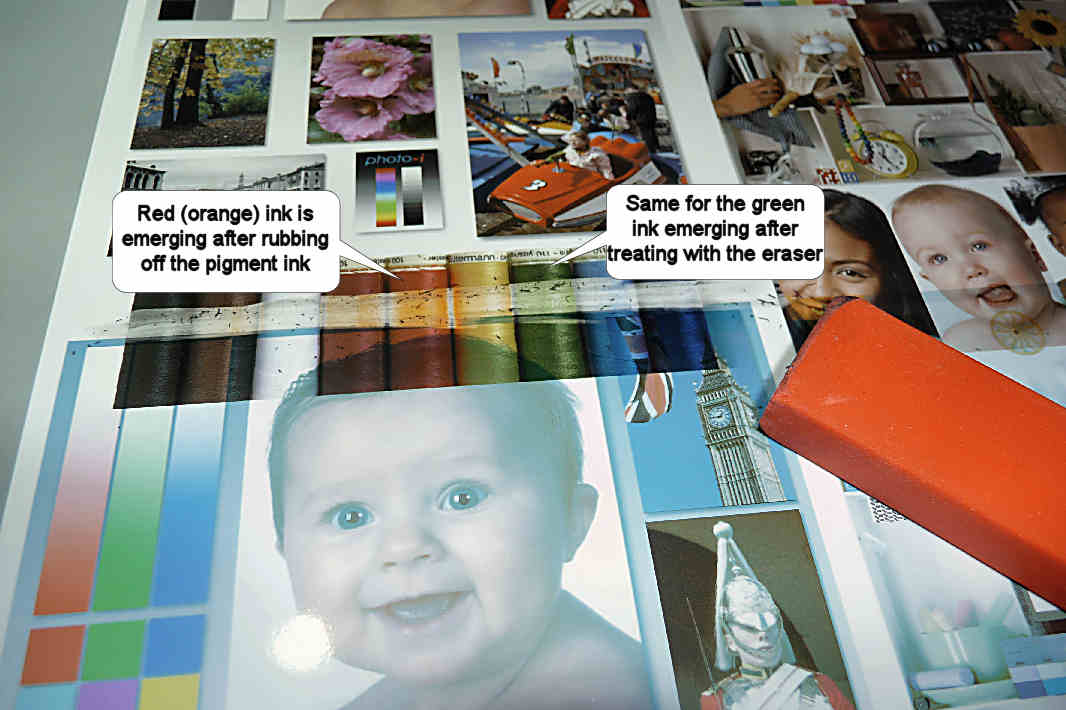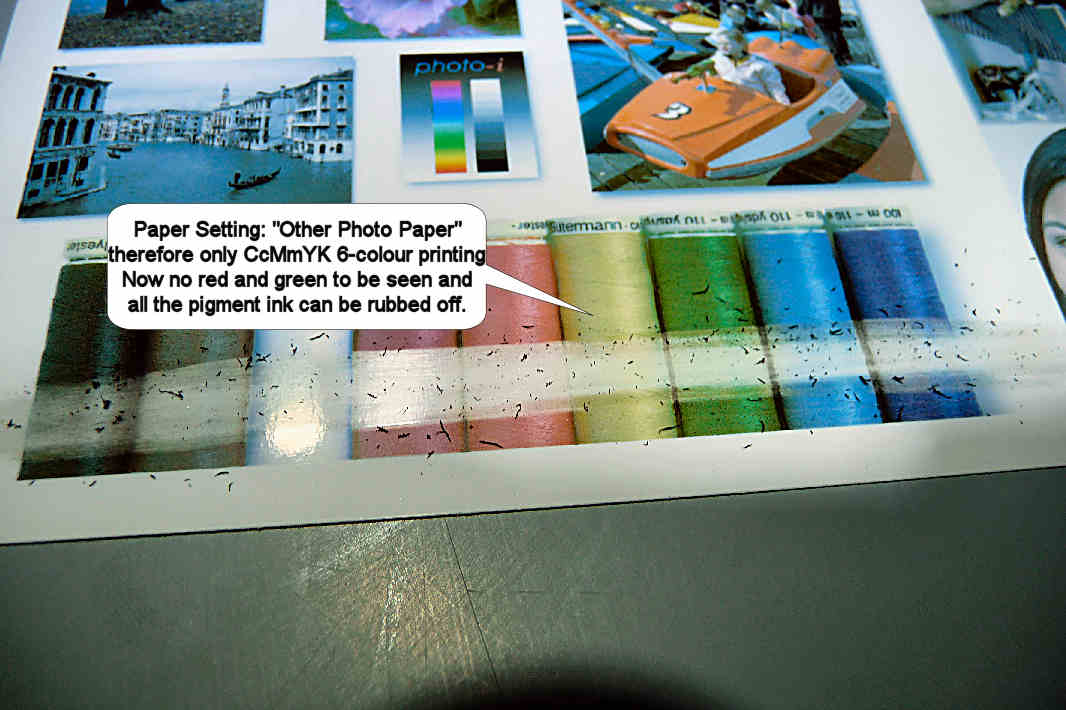- Joined
- May 29, 2007
- Messages
- 2,565
- Reaction score
- 1,269
- Points
- 313
- Location
- Ghent, Belgium
- Printer Model
- Epson SC-P800,WF-7840,XP-15000
As you might know, a few months ago I tried to put pigment ink (pigment text black) into my dye based IP6600D printer (photo magenta cartridge) and to my surprise it actually works !!!
See the picture below:
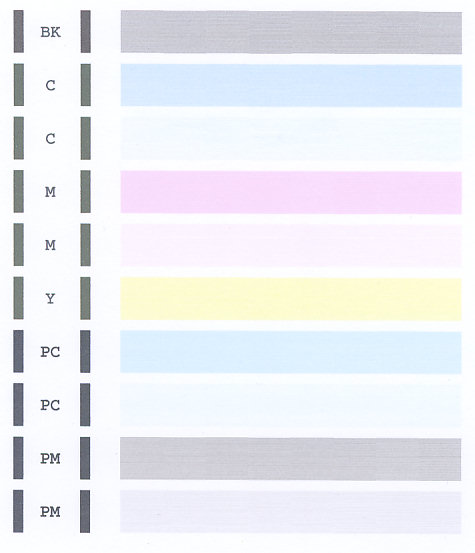
So far the printhead is still healthy and this encourages me to use my larger Canon i9950 A3+ printer to extend my experiments.
The reason for using the Canon i9950 are the following facts:
-print resolution: 4800x2400 dpi @ 2 pl versus the 9600x4800 dpi @ 1pl for the IP6600D
-as such: larger droplets, less risk of clogs due to the nature of pigment ink
-strong suspicion that the prosumer Canon Pro 9500 (10 cartridges) is actually based on the same printhead design, just have a look at the picture below:
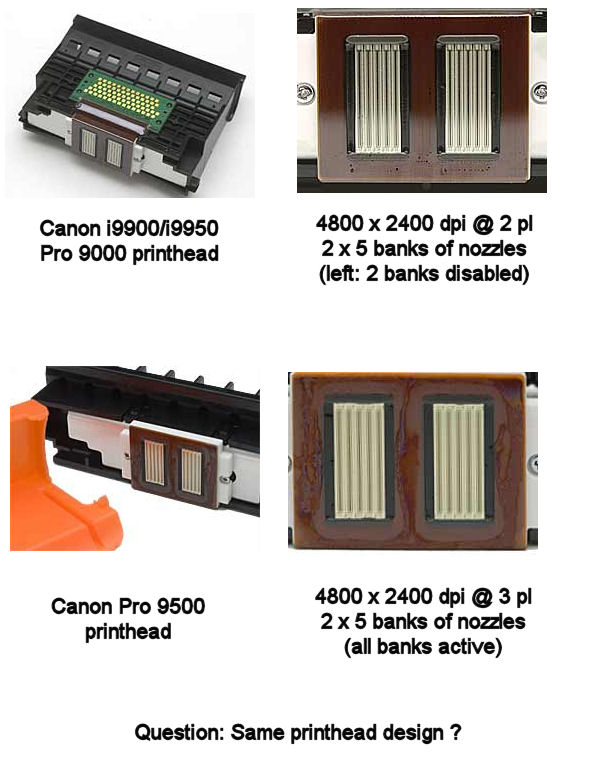
As you can see: both the i9950 and the Pro 9500 have 2x5 banks of print nozzles of which the i9950 has 2 banks disabled. I think Canon has deliberately done this in order to enable the extra 2 banks in a later stadium of its development of newer (pigment) printers. This would save on development and new fabrication (lines) costs. The production of the printhead with the full lithographic process will be the most expensive/advanced part of producing new printers. So far my theoretical thoughts about the 2 disabled banks on the i9950. Note: the former Canon i990 has an extra bank disabled on the left (only red as extra colour), with still the same printhead design. Can this be a coincidence ?
I onced tried to put Epson K3 compatible pigment ink in one of my cartridges to see if my printhead can actually handle the ink and indeed: it can, but this type of ink is especially formulated to be expelled from the nozzles by a pressure change from the piezo crystal and the physical properties of this ink lead to massive ghost droplets when trying to print stroke of the same colour (in my case it was magenta) and when increasing the printing speed the printhead could not catch up with the faster speed and would cause banding. I think that the viscosity is increased inside the nozzle by the heating process, which evaporates part of the liquid medium carrying the pigments and the droplets tends to be expelled from the printhead with some delay. See picture below:
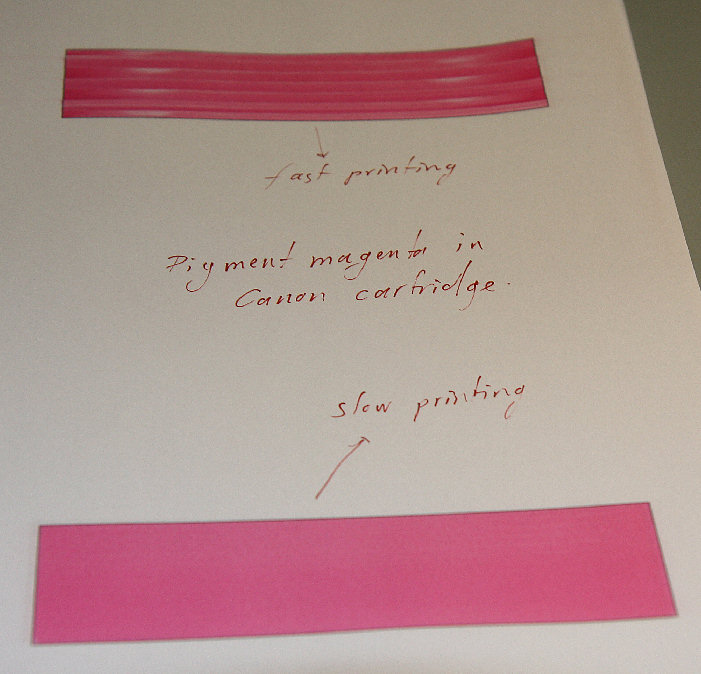
Encouraged by these preliminary results I asked Mikling of Precisioncolors.com some sample inks, which are compatible with the bubblejet print technology. The only ink he could provide me was the HP B9180 compatible pigment ink set which is guaranteed to work with the bubblejet technology (Canon and HP). Unfortunately there was no red (orange) and green pigment ink. Therefore I could only obtain cyan, photo cyan, magenta, photo magenta, yellow and photoblack (CcMmYK).
The following pictures showed the setup of my experiment with 6 clean cartridges filled with this particular ink:
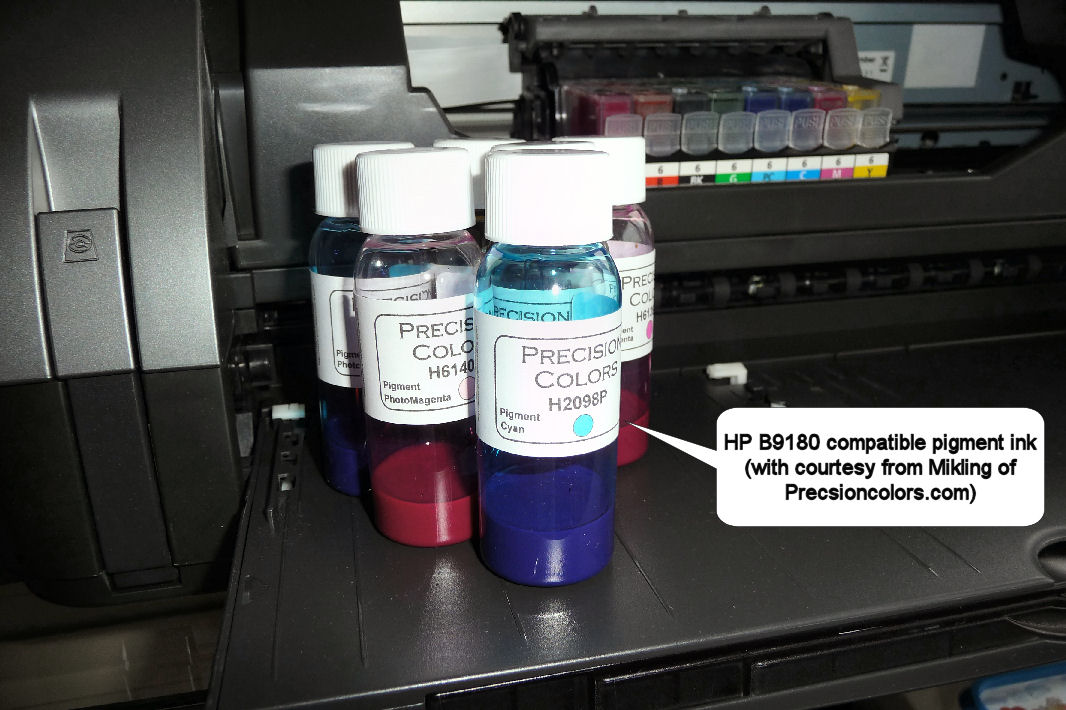
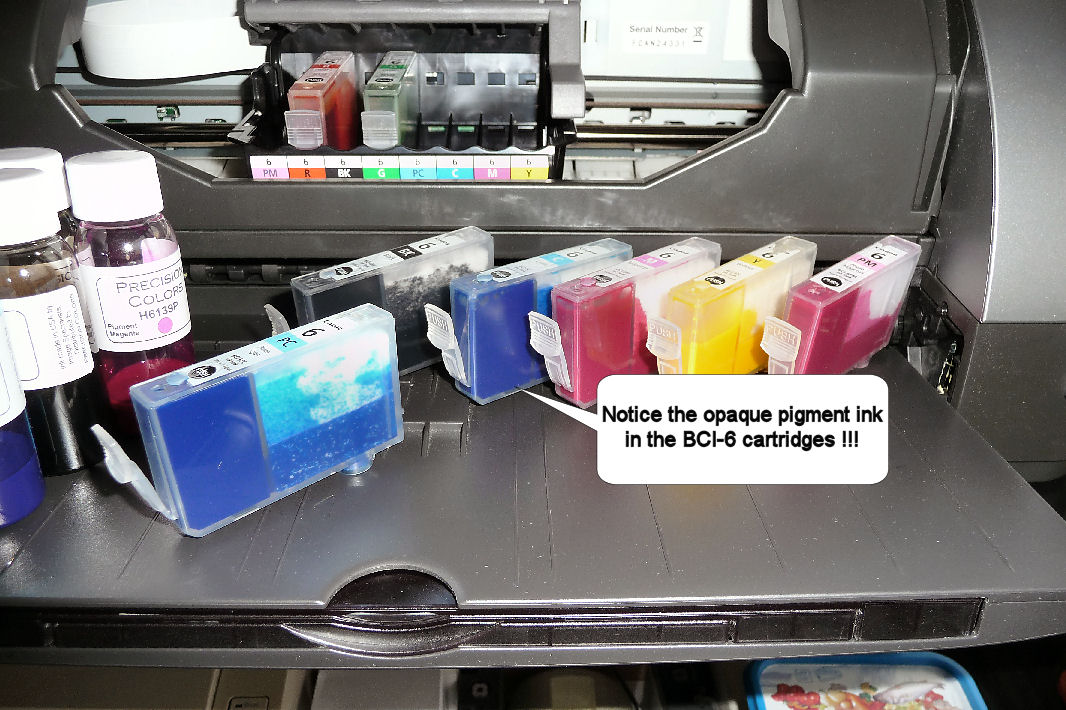
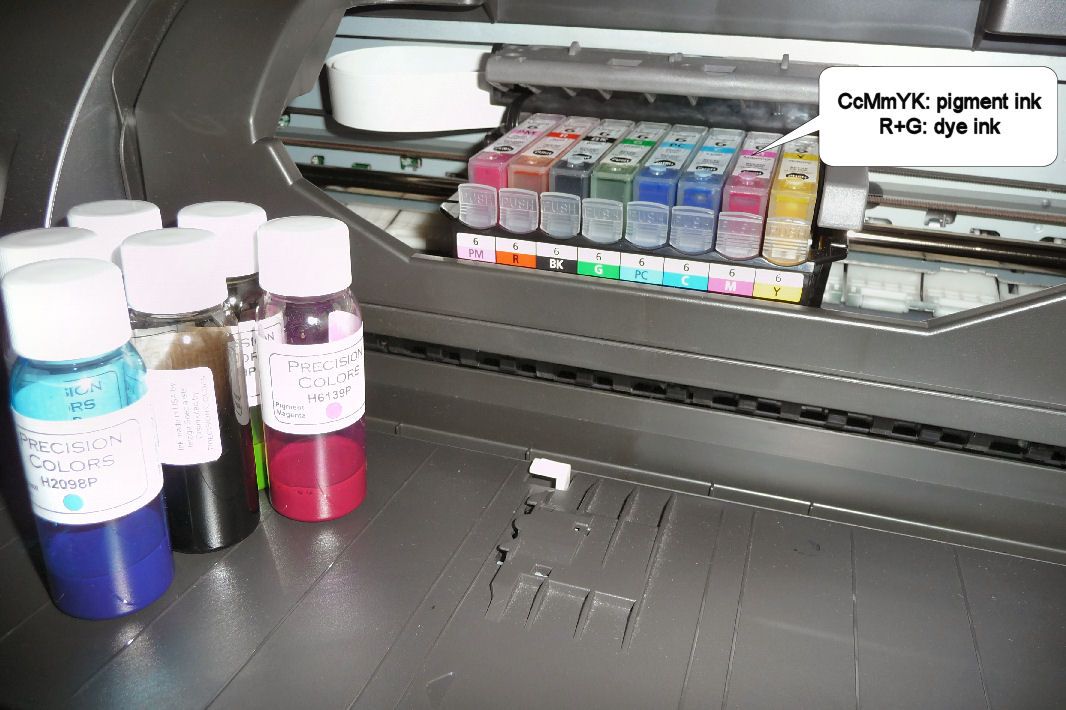
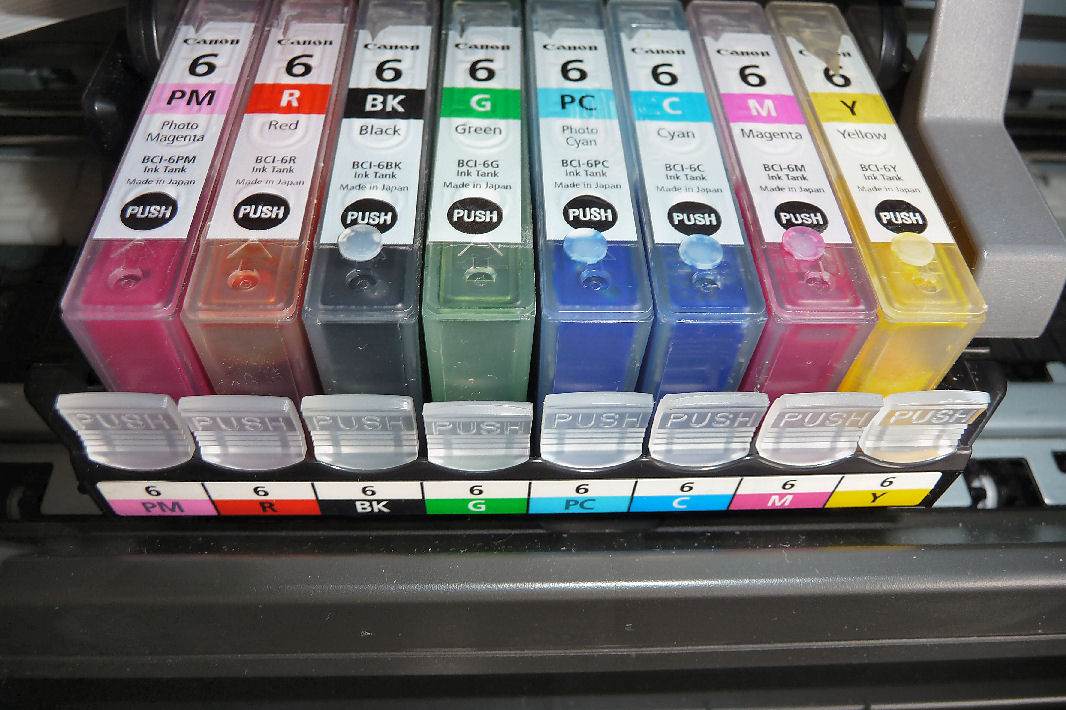
Now with all the 6 cartridges (CcMmYK) installed and after 2 cleaning cycles to flush out the dye ink I made a nozzle check to see, what the result was:
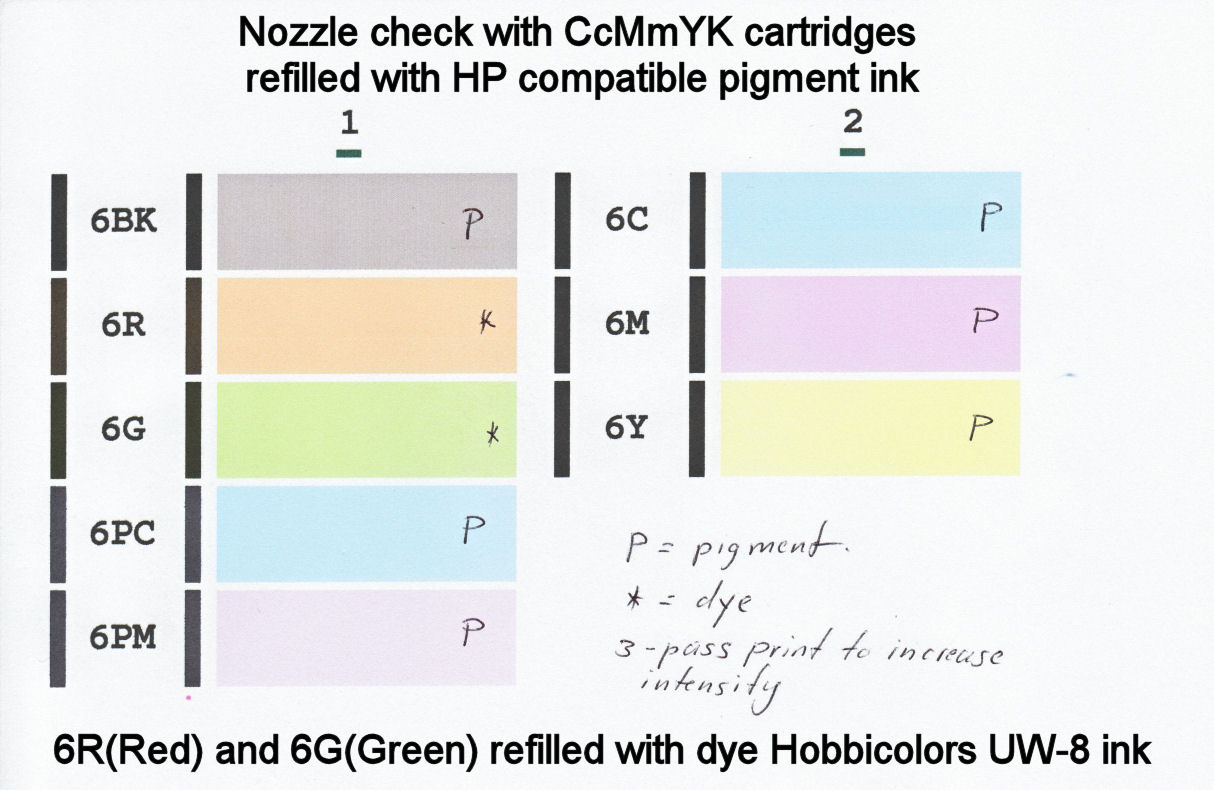
Notice the * I put on the 6R and 6G nozzle band to indicate these cartridges are still dye based. I was surprised the nozzle check was 100 % OK the first time. Since the actual nozzle check printout was a bit light for the scanner I inserted the paper 3 times to make a over print over the same area to increase the intensity.
Now the question would be: is all the dye ink removed from the printhead after 2 cleaning cycles or not ? Well: I put a drop of water on each colour band and let it absorb until completely dry and made a scan again and this is the result:
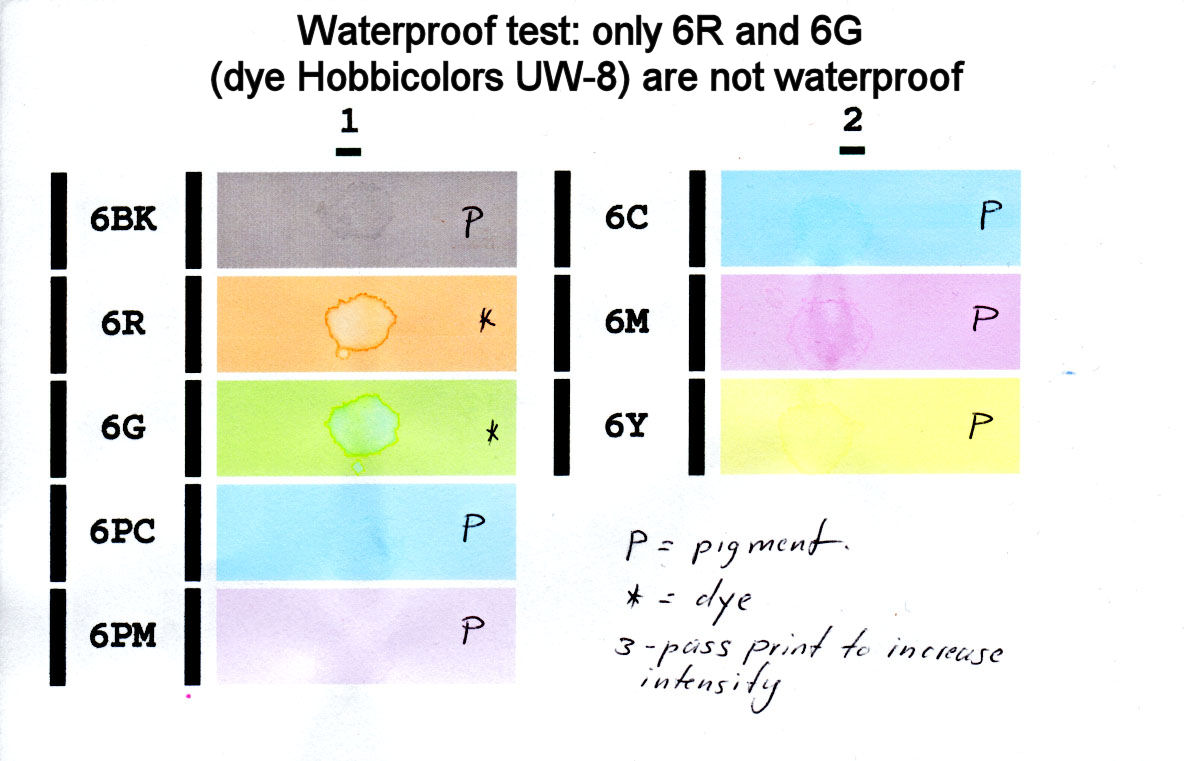
The pictures shows now clearly the difference between the dye inks in the 6R and the 6G cartridges. The pigment ink is hardly affected by water and does not run: notice the diffusion ring in both the 6R and 6G dye ink bands.
This preliminary result is quite exciting, so I started to make print on high glossy photo paper to see what the result will be, and this what I get:
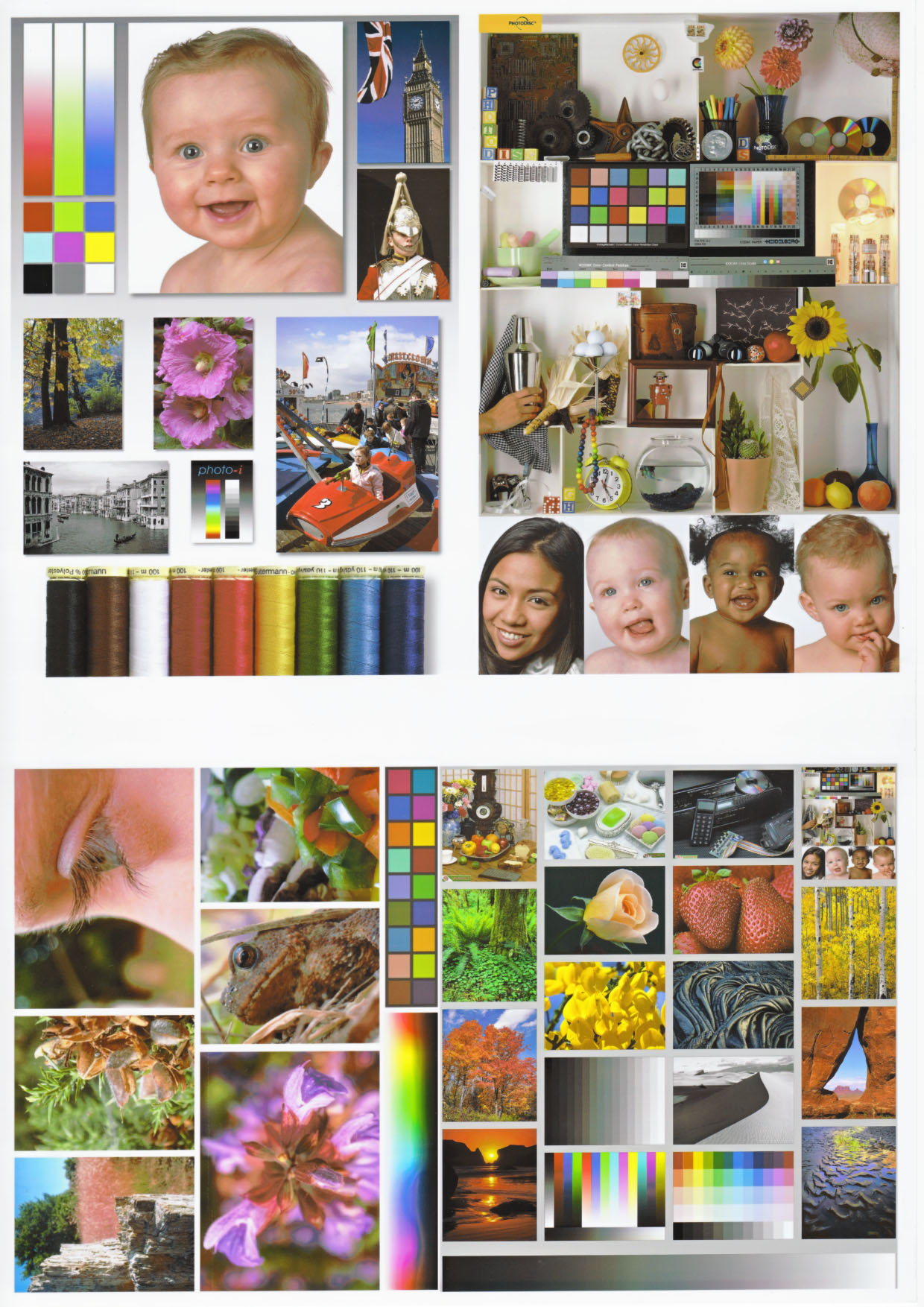
The above picture is printed using a custom profile to correct for the differences due to the switch from dye to pigment ink. The result is really astonishing good for this first test.
Is everything well and good ? No: the problem I think is due to the paper, which can not absorb the ink well, causing easy rub off:
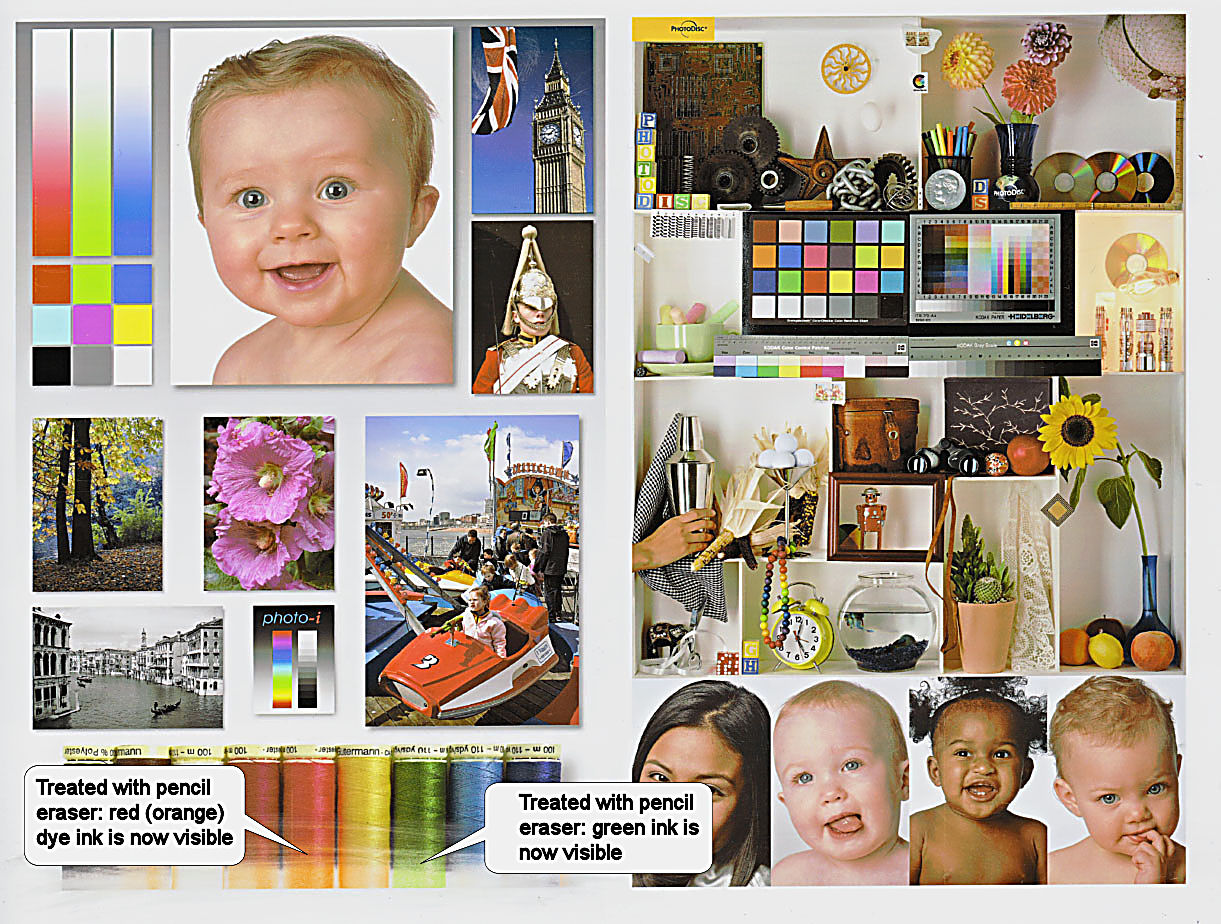
Since the paper setting of Glossy Photo Paper Extra is also using the red and green inks, which is emerged onto the surface after I use a pencil eraser to rub off the pigment ink.
This particular problem has to be tackled to get satisfactory results. Printing is good, but the ink does not adhere well on this microporous paper, which is quite annoying.
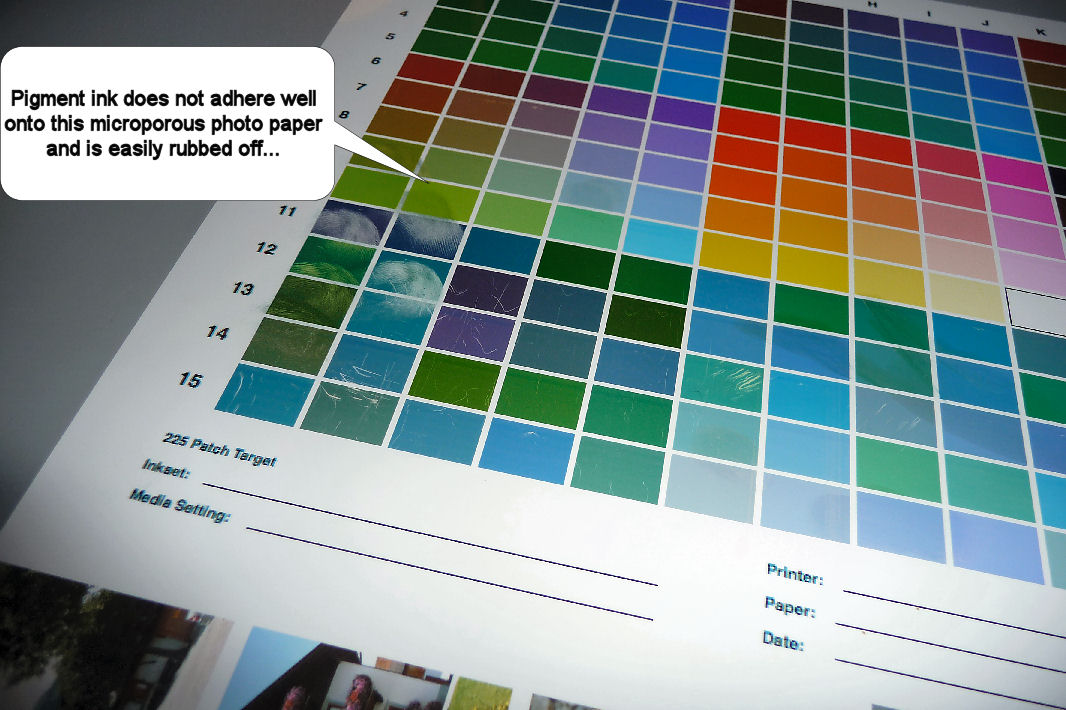
As you can see on the above pictre: the ink/paper combination is far from satisfactory.
Here are some pictures I made from the sheets printed with the pigment ink cartridges installed in my Canon i9950 and see for yourself:
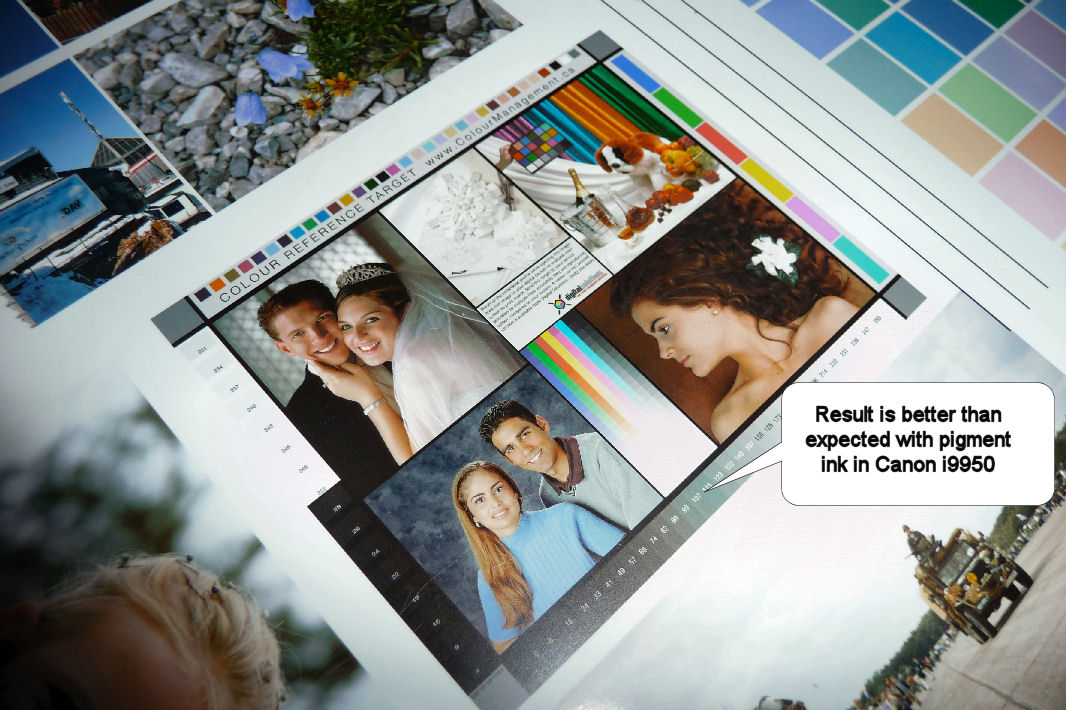
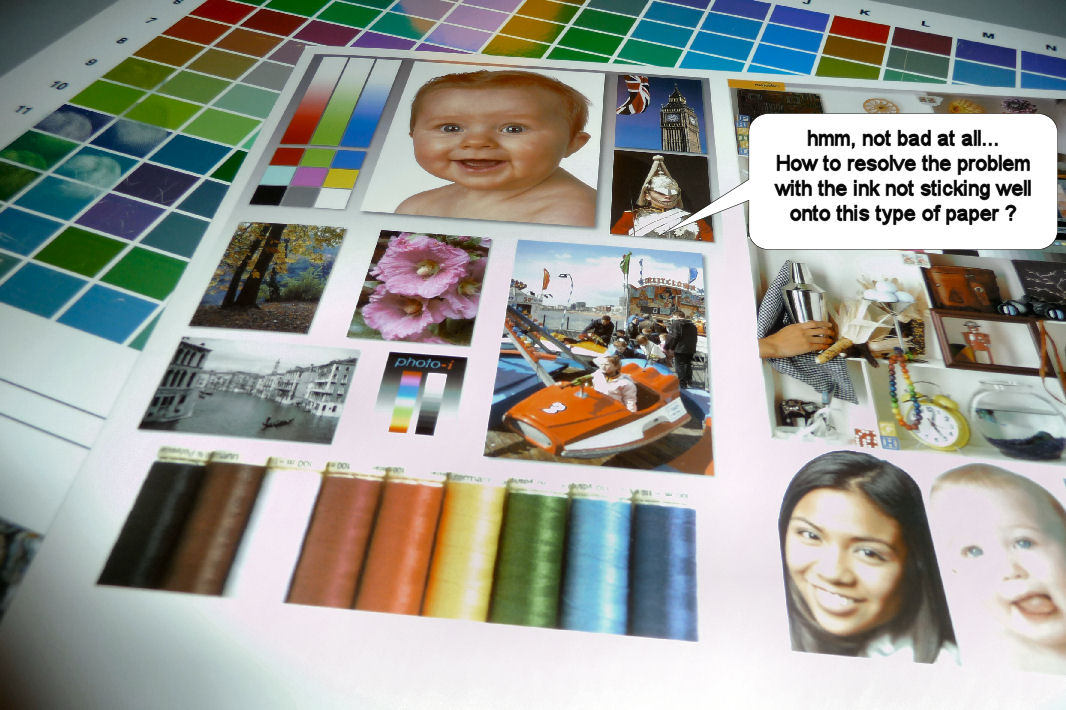
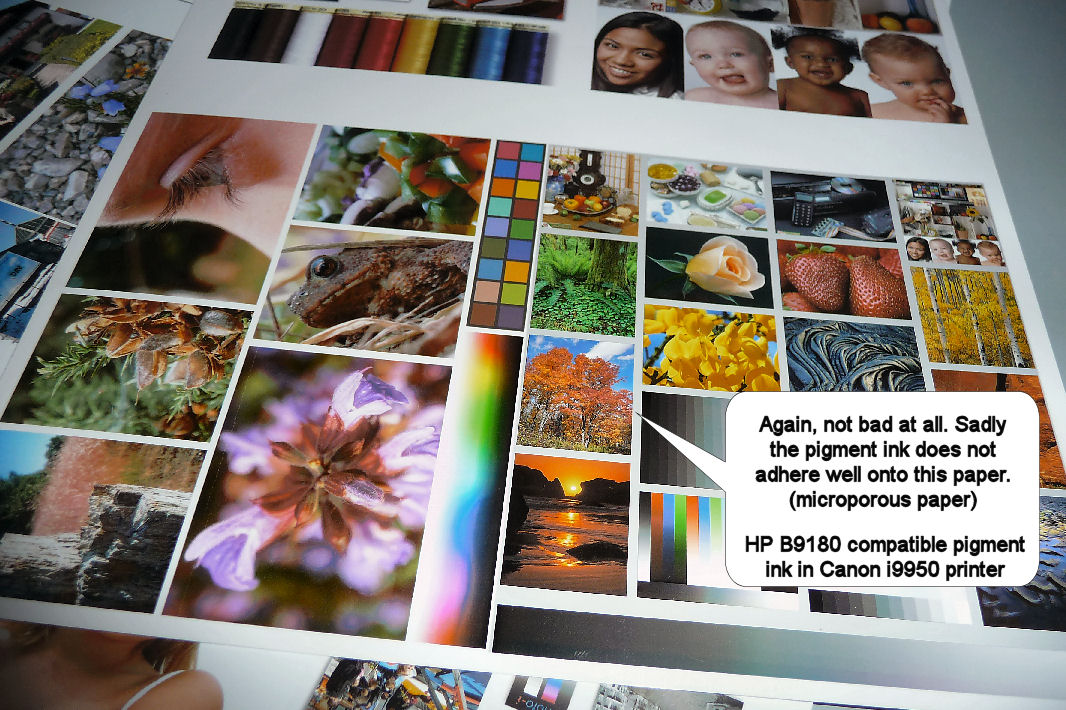
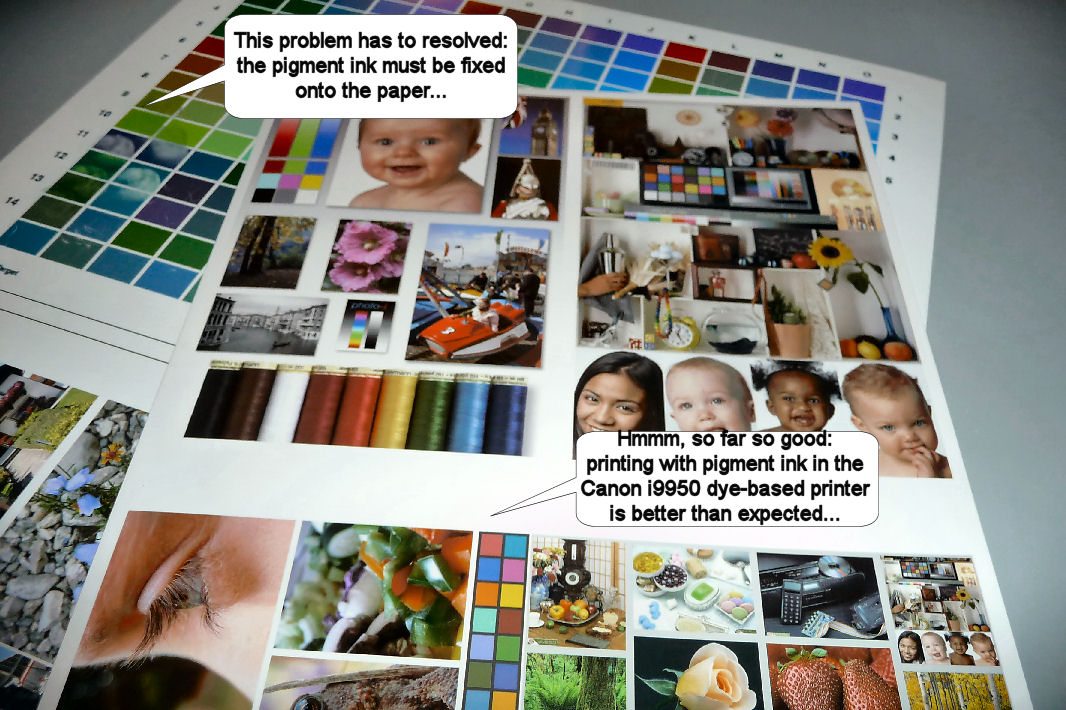
The results are far better than expected and strengthen my believe the Canon i9950 is capable to handle pigment ink well and in fact is using the same printhead design as the Canon Pro 9500 (can someone confirm this ?). The above picture how good actually the printing is.
Some thoughts about this experiment:
-the need for red and green pigment inks to complete the whole inkset
-long term printing may requires spongeless cartridges to have the ink shaken well to keep the pigment particles homogenously suspended like the original PGI-9 pigment cartridges. The PGI-9 cartridges have a spring inside to shake the ink continuously when the printhead is moving during printing.
-the right paper to receive the ink, that will not let the ink to be easily rubbed off, like I do experience with my photo paper.
Thats all folks for this moment !
See the picture below:

So far the printhead is still healthy and this encourages me to use my larger Canon i9950 A3+ printer to extend my experiments.
The reason for using the Canon i9950 are the following facts:
-print resolution: 4800x2400 dpi @ 2 pl versus the 9600x4800 dpi @ 1pl for the IP6600D
-as such: larger droplets, less risk of clogs due to the nature of pigment ink
-strong suspicion that the prosumer Canon Pro 9500 (10 cartridges) is actually based on the same printhead design, just have a look at the picture below:

As you can see: both the i9950 and the Pro 9500 have 2x5 banks of print nozzles of which the i9950 has 2 banks disabled. I think Canon has deliberately done this in order to enable the extra 2 banks in a later stadium of its development of newer (pigment) printers. This would save on development and new fabrication (lines) costs. The production of the printhead with the full lithographic process will be the most expensive/advanced part of producing new printers. So far my theoretical thoughts about the 2 disabled banks on the i9950. Note: the former Canon i990 has an extra bank disabled on the left (only red as extra colour), with still the same printhead design. Can this be a coincidence ?
I onced tried to put Epson K3 compatible pigment ink in one of my cartridges to see if my printhead can actually handle the ink and indeed: it can, but this type of ink is especially formulated to be expelled from the nozzles by a pressure change from the piezo crystal and the physical properties of this ink lead to massive ghost droplets when trying to print stroke of the same colour (in my case it was magenta) and when increasing the printing speed the printhead could not catch up with the faster speed and would cause banding. I think that the viscosity is increased inside the nozzle by the heating process, which evaporates part of the liquid medium carrying the pigments and the droplets tends to be expelled from the printhead with some delay. See picture below:

Encouraged by these preliminary results I asked Mikling of Precisioncolors.com some sample inks, which are compatible with the bubblejet print technology. The only ink he could provide me was the HP B9180 compatible pigment ink set which is guaranteed to work with the bubblejet technology (Canon and HP). Unfortunately there was no red (orange) and green pigment ink. Therefore I could only obtain cyan, photo cyan, magenta, photo magenta, yellow and photoblack (CcMmYK).
The following pictures showed the setup of my experiment with 6 clean cartridges filled with this particular ink:




Now with all the 6 cartridges (CcMmYK) installed and after 2 cleaning cycles to flush out the dye ink I made a nozzle check to see, what the result was:

Notice the * I put on the 6R and 6G nozzle band to indicate these cartridges are still dye based. I was surprised the nozzle check was 100 % OK the first time. Since the actual nozzle check printout was a bit light for the scanner I inserted the paper 3 times to make a over print over the same area to increase the intensity.
Now the question would be: is all the dye ink removed from the printhead after 2 cleaning cycles or not ? Well: I put a drop of water on each colour band and let it absorb until completely dry and made a scan again and this is the result:

The pictures shows now clearly the difference between the dye inks in the 6R and the 6G cartridges. The pigment ink is hardly affected by water and does not run: notice the diffusion ring in both the 6R and 6G dye ink bands.
This preliminary result is quite exciting, so I started to make print on high glossy photo paper to see what the result will be, and this what I get:

The above picture is printed using a custom profile to correct for the differences due to the switch from dye to pigment ink. The result is really astonishing good for this first test.
Is everything well and good ? No: the problem I think is due to the paper, which can not absorb the ink well, causing easy rub off:

Since the paper setting of Glossy Photo Paper Extra is also using the red and green inks, which is emerged onto the surface after I use a pencil eraser to rub off the pigment ink.
This particular problem has to be tackled to get satisfactory results. Printing is good, but the ink does not adhere well on this microporous paper, which is quite annoying.

As you can see on the above pictre: the ink/paper combination is far from satisfactory.
Here are some pictures I made from the sheets printed with the pigment ink cartridges installed in my Canon i9950 and see for yourself:




The results are far better than expected and strengthen my believe the Canon i9950 is capable to handle pigment ink well and in fact is using the same printhead design as the Canon Pro 9500 (can someone confirm this ?). The above picture how good actually the printing is.
Some thoughts about this experiment:
-the need for red and green pigment inks to complete the whole inkset
-long term printing may requires spongeless cartridges to have the ink shaken well to keep the pigment particles homogenously suspended like the original PGI-9 pigment cartridges. The PGI-9 cartridges have a spring inside to shake the ink continuously when the printhead is moving during printing.
-the right paper to receive the ink, that will not let the ink to be easily rubbed off, like I do experience with my photo paper.
Thats all folks for this moment !

